General officer
A general officer is an officer of high rank in the army, and in some nations' air forces, space forces, or marines.[lower-alpha 1]
The term general is used in two ways: as the generic title for all grades of general officer and as a specific rank. It originates in the 16th century, as a shortening of captain general, which rank was taken from Middle French capitaine général. The adjective general had been affixed to officer designations since the late medieval period to indicate relative superiority or an extended jurisdiction.
Today, the title of general is known in some countries as a four-star rank. However, different countries use different systems of stars or other insignia for senior ranks. It has a NATO code of OF-9 and is the highest rank currently in use in a number of armies, air forces, and marine organizations.
General officer ranks
The various grades of general officer are at the top of the military rank structure. Lower-ranking officers in land-centric military forces are typically known as field officers or field-grade officers, and below them are company-grade officers.
Common systems
There are two common systems of general ranks used worldwide. In addition, there is a third system, the Arab system of ranks, which is used throughout the Middle East and North Africa but is not used elsewhere in the world.
Variations of one form, the old European system, were once used throughout Europe. It is used in the United Kingdom (although it did not originate there), from which it eventually spread to the Commonwealth and the United States of America. The general officer ranks are named by prefixing "general", as an adjective, with field officer ranks, although in some countries the highest general officers are titled field marshal, marshal, or captain general.
The other is derived from the French Revolution, where generals' ranks are named according to the unit they (theoretically) command.
Old European system
| Field marshal or general field marshal |
|---|
| Colonel general |
| General |
| Lieutenant general |
| Sergeant major general or major general |
| Brigadier or brigadier general |
The system used either a brigadier general or a colonel general rank (i.e. exclude one of the italicised ranks).
The rank of field marshal was used by some countries as the highest rank, while in other countries it was used as a divisional or brigade rank. Many countries (notably pre-revolutionary France and eventually much of Latin America) actually used two brigade command ranks, which is why some countries now use two stars as their brigade general insignia. Mexico and Argentina still use two brigade command ranks.
In some nations (particularly in the Commonwealth since the 1920s), the equivalent to brigadier general is brigadier, which is not always considered by these armies to be a general officer rank, although it is always treated as equivalent to the rank of brigadier general for comparative purposes.
As a lieutenant outranks a sergeant major; confusion often arises because a lieutenant is outranked by a major. Originally the serjeant major was, exclusively, the commander of the infantry, junior only to the captain general and lieutenant general. The distinction of serjeant major general only applied after serjeant majors were introduced as a rank of field officer. Serjeant was eventually dropped from both rank titles, creating the modern rank titles. Serjeant major (later spelled sergeant major) as a senior rank of non-commissioned officer was a later creation.
French (Revolutionary) system
| Marshal or Captain general |
|---|
| Army general |
| Army corps general |
| Divisional general |
| Brigade general |
Arab system
The armies of Arab countries use traditional Arabic titles. These were formalized in their current system to replace the Turkish system that was formerly in use in the Arab world and the Turco-Egyptian ranks in Egypt.
| Rank | Translation | Notes | ||
| مشير | mushīr | Counsellor | compare Counsellor of State, State Counsellor etc. compare etymology "mushir" with "shura" | |
| فريق أول | farīq awwal | First general | equivalent to Commonwealth "full" general | |
| فريق | farīq | General | equivalent to lieutenant general or corps general | |
| لواء | liwāʾ | Ensign | (more loosely "flag officer" or "banner") | |
| عميد | ʿamīd | Colonel (not to be confused with aqīd, the equivalent rank to a Commonwealth colonel) |
compare etymology with "ʿamood" ("column"); etymologically, translates as "colonel" but equivalent to brigadier/brigade general | |
Other variations
Other nomenclatures for general officers include the titles and ranks:
- Adjutant general
- Commandant-general
- Inspector general
- General-in-chief
- General of the Army (which is distinct from the title army general)
- General of the Air Force (USAF only)
- General of the Armies of the United States (of America), a title created for General John J. Pershing, and subsequently granted posthumously to George Washington
- Generaladmiral ("general admiral") (German Navy)
- Air general and aviation general (Chilean Air Force; roughly equivalent to air chief marshal and air vice-marshal)
- Wing general and group general (Mexican Air Force; roughly equivalent to air commodore and acting air commodore)
- General-potpukovnik ("lieutenant colonel general", a Serb/Slovenian/Macedonian rank immediately inferior to colonel general, and roughly equivalent to Commonwealth/US major general)
- Director general (a common administrative term sometimes used as an appointment in military services)
- Director general of national defence (most senior rank in the Mexican Armed Forces)
- Controller general (general officer rank in the French National Police)
- Prefect general (the most senior rank of the Argentine Naval Prefecture)
- Master-General of the Ordnance – very senior British military position.
- Police General (most senior rank of the Philippine National Police).
- Commissioner (highest rank of the Bureau of Immigration)
- Admiral (highest rank of the Philippine Coast Guard & Philippine Navy)
In addition to militarily educated generals, there are also generals in medicine and engineering. The rank of the most senior chaplain, (chaplain general), is also usually considered to be a general officer rank.
Specific rank of general
In the old European system, a general, without prefix or suffix (and sometimes referred to informally as a "full general"), is usually the most senior type of general, above lieutenant general and directly below field marshal as a four-star rank (NATO OF-9).
Usually it is the most senior peacetime rank, with more senior ranks (for example, field marshal, marshal of the air force, fleet admiral) being used only in wartime or as honorary titles.
In some armies, however, the rank of captain general, general of the army, army general or colonel general occupied or occupies this position. Depending on circumstances and the army in question, these ranks may be considered to be equivalent to a "full" general or to a field marshal five-star rank (NATO OF-10).
The rank of general came about as a "captain-general", the captain of an army in general (i.e., the whole army). The rank of captain-general began appearing around the time of the organisation of professional armies in the 17th century. In most countries "captain-general" contracted to just "general".
General ranks by country
The following articles deal with the rank of general, or its equivalent, as it is or was employed in the militaries of those countries:
- General (Australia)
- General (Bangladesh)
- General (Brazil)
- General (Canada)
- Shang Jiang (China) – People's Republic of China (PRC) and Republic of China (ROC/Taiwan)
- Kindral (Estonia)
- Général (France)
- General (Germany)
- SS-Oberst-Gruppenführer (Nazi Germany, SS four-star rank, equal to a Wehrmacht Generaloberst)
- Generaloberst der Ordnungspolizei (Nazi Germany, police four-star rank)
- Armeegeneral (East Germany, four-star rank)
- Στρατηγός (Strategos) (Greece)
- General (Pakistan)
- General (India)
- Aluf (אלוף, Israel)
- Generale (Italy)
- Rikugun-Taishō (IJA), Rikushō serve as chief of staff and Kūshō serve as chief of staff (JSDF, four-star rank) (Japan)
- Daejang (North Korea and South Korea)
- General (Mexico)
- Heneral (Philippines)
- Generał (Poland)
- General of the army (Russian: генерал армии), Russia since 1992
- General (генерал) - Imperial Russian Army until 1917
- General of the army (генерал армии), Soviet Union until 1992
- General (Sri Lanka)
- General (Sweden)
- General (Switzerland)
- General (United Kingdom)
- General (United States)
- Đại tướng (Vietnam)
- General (Yugoslav People's Army)
- General (Zimbabwe)
Army generals' insignia
.svg.png)
Setar Jenral
(Afghan National Army)
Teniente General
(Argentine Army)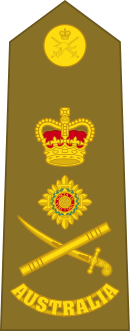

General
(Bangladesh Army)

Генерал
(Bulgarian Army)
នាយឧត្តមសេនីយ៍ – Neay Odomsenei
(Cambodian Army)

General de Ejército
(Chilean Army)
一級上將
Yi Ji Shang Jiang
(Republic of China Army)
二級上將
er Ji Shang Jiang
(Republic of China Army)
上将
Shang Jiang
(People's Liberation Army)
General
(Colombian Army)
General de Ejército
(Cuban Revolutionary Armed Forces)
Armádní Generál
(Army of the Czech Republic)
General
(Royal Danish Army)
General
(Land Forces of DR Congo)
General de Ejercito
(Ecuadorian Army)



General
(Armed Forces of Gabon)
არმიის გენერალი
(Georgian Defense Forces)
_Minister_of_Defence_rank_insignia.svg.png)
General
(Guyana Defence Force)


Arteshbod, ارتشبد
(Iranian Corps)
Arteshbod, ارتشبد
(Iranian Army)
.svg.png)
Generale
(Italian Army).svg.png)

Taejang (대장)
(Korean People's Army)
Daejang (대장)
(Republic of Korea Army)
генерал
(Army of the Republic of North Macedonia)


Général
(Moroccan Army)
General
(Namibian Army)



Heneral
(Philippine Army)
Generał
(Polish Army)
General
(Portuguese Army)

General
(Russian Ground Forces)
General
(Rwandan Defence Forces)
Генерал
(Serbian Army)
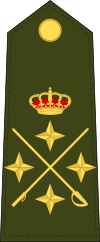


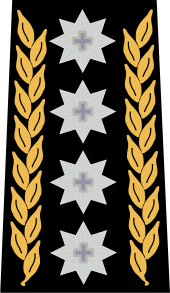
General
(Swiss Land Forces)
عماد أول
(Syrian Arab Army).svg.png)
พลเอก – Phon Ek
(Royal Thai Army)
Orgeneral
(Turkish Land Forces)
Orgeneral (Chief of Staff)
(Turkish Land Forces)
Colonel General
(Ukrainian Ground Forces)


Armiya Generali
(Uzbekistan Ground Forces)

farīq awwal
(Yemeni Army)

Air force generals' insignia



General del Aire
Chilean Air Force

General
(Royal Danish Air Force)
Kindral
(Õhuvägi – Estonian Air Force)
Général d´armée aérienne
French Air Force
არმიის გენერალი
(Georgian Air Force)

Aluf (אלוף)
(Israeli Air Force)
Generale
(Italian Air Force).svg.png)

Taejang (대장)
(Korean People's Army Air Force (North Korea))
Daejang (대장)
(Republic of Korea Air Force (South Korea))

Général
(Royal Moroccan Air Force)

General
Royal Norwegian Air Force
Heneral
(Philippine Air Force

General
(Portuguese Air Force)General
(Romanian Air Force)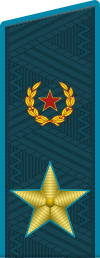
General
(Russian Air Force)
Генерал
(Serbian Air Force)
General
(South African Air Force)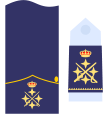
General del Aire
(Spanish Air Force)
General
(Swedish Air Force)
Orgeneral
(Turkish Air Force)
Naval infantry generals' insignia

General
(Swedish Amphibious Corps)


Generals' insignia of disbanded armies
_5.svg.png)


.png)

上将
(Inner Mongolian Army)
Heneral
General
(Philippine Revolutionary Army)
General
(Rhodesian Army)
Army general
(Army of the Soviet Union)
Đại Tướng, 1967–1975
(Army of the Republic of Vietnam)
Air force and naval equivalents
Some countries (such as the United States) use the general officer ranks for both the army and the air force, as well as their marine corps; other nations only use the general officer ranks for the army, while in the air force they use air officers as the equivalent of general officers. They use the air force rank of air chief marshal as the equivalent of the specific army rank of general. This latter group includes the British Royal Air Force and many current and former Commonwealth air forces—e.g. Royal Australian Air Force, Indian Air Force, Royal New Zealand Air Force, Nigerian Air Force, Pakistan Air Force, etc.
In most navies, flag officers are the equivalent of general officers, and the naval rank of admiral is equivalent to the specific army rank of general. A noteworthy historical exception was the Cromwellian naval rank "general at sea". In recent years in the American service there is a tendency to use flag officer and flag rank to refer to generals and admirals of the services collectively.
See also
Notes
- In the United States, General Officers authorized to display a flag showing their rank are also called "flag officers". Refer: "Flag officer". Merriam-Webster.. In other nations the term "flag officer" usually applies to admirals.
- Chief of Joint Staff Japan Self-Defense Forces and Chief of Staff Japan Ground Self-Defense Force.
- Chief of Joint Staff Japan Self-Defense Forces and Chief of Staff Japan Air Self-Defense Force.
References
External links
| Look up general officer in Wiktionary, the free dictionary. |
- Generals of World War II
- Schema-root.org: US Generals News feeds for US Generals in the news
- Marines.mil: General Officer Biographies Biographies of US Marine Corps General Officers
- Bios & Information on Generals of Western History Information on 10 Generals who influenced Western History